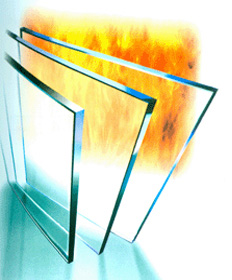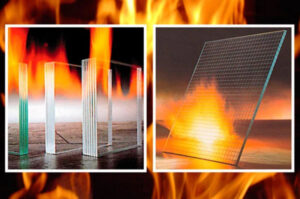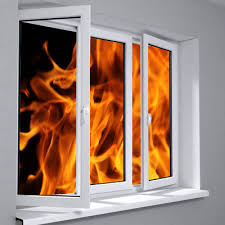The difference between fire-resistant glass and ordinary glass

In the world of modern architectural design, the role of glass is not limited to beauty and transparency, but goes beyond it to include elements of safety and protection. Hence the appearance of what is known as “fire-resistant glass”, which is a type of glass specially designed to withstand high temperatures and prevent the spread of flame and smoke, unlike ordinary glass that collapses quickly when exposed to fire. In this article, we explain the essential difference between fire-resistant glass and ordinary glass in terms of composition, performance, use, and cost.

- Composition and materials
Normal Glass:
It usually consists of a single layer of heat-treated silica. Does not contain additional layers or heat-resistant materials.
Fire Resistant Glass:
It is made of several layers of glass separated by transparent materials that are resistant to heat such as gel or special ceramics. These layers delay the transfer of heat and flame, and maintain the cohesion of the glass for specific periods of time (30, 60, 90, or even 120 minutes).
- Performance in case of fire
Normal Glass:
It begins to crack at about 150-250 °C, and completely explodes or shatters when the temperature reaches 300-400 °C, allowing the passage of flames and smoke.
Fire Resistant Glass:
Withstands temperatures up to 1000 °C, maintains its shape and structure long enough to allow evacuations and fire extinguishing, and prevents the transmission of flames and toxic gases.

- Uses and Applications
Normal Glass:
It is used in windows, doors, facades, and interior dividers that do not require fire resistance.
Fire Resistant Glass:
It is used in exits and emergency corridors, server rooms, hospitals, government buildings, factories, and hotels, where fire safety is a priority.
- Cost
Normal Glass:
Low cost, making it the first choice in projects that do not require special security specifications.

Fire Resistant Glass:
Relatively more expensive due to the complexity of its manufacture and technical characteristics, but it is an important investment in safety projects.
- Accreditations and Standards
Fire-resistant glass is subject to precise standards such as:
EN 1364 / EN 13501 (Europe)
UL 263/ASTM E119 (US)
While ordinary glass does not need accreditations of this type.

Conclusion
The main difference between ordinary glass and fire-resistant glass lies in the functional purpose. Plain glass serves simple aesthetic or functional goals, while fire-resistant glass is a critical security element in building design. Choosing the right type depends on the requirements of the project and the required safety criteria